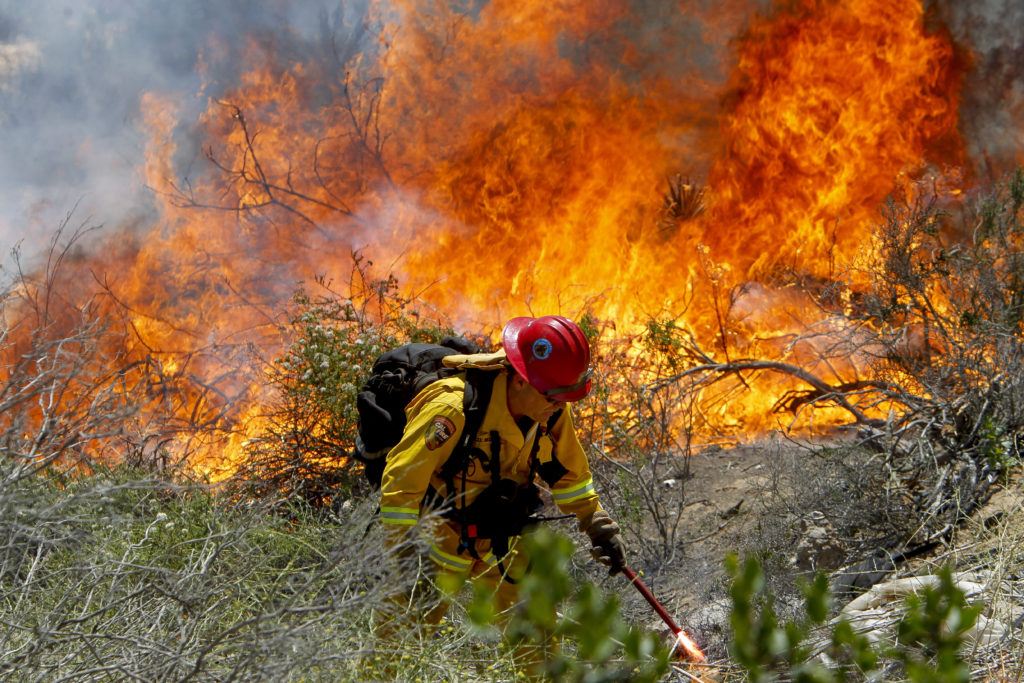California investigators have determined that PG&E Corp.’s power lines ignited the deadliest blaze in state history, opening the door for more liabilities that the company has already warned may exceed $30 billion.
A transmission line owned by PG&E sparked the Camp Fire that killed 85 people and destroyed an entire town in November, the California Department of Forestry and Fire Protection said in a statement Wednesday. The agency forwarded its investigation to the Butte County district attorney, a move that may suggest the company was in violation of regulations.
The news came just as PG&E’s new chief executive officer, Bill Johnson, was explaining to state legislators in Sacramento why he is the right person to lead the power giant, which filed for Chapter 11 in January to deal with crippling wildfire liabilities. Its bankruptcy, the biggest for a utility in U.S. history, has attracted some of the largest names in distressed debt, including Elliott Management Corp. PG&E has asked for six months to develop a restructuring plan. California Governor Gavin Newsom wants one sooner.
Junk Rating
PG&E shares were little changed in after-hours trading after plunging by as much as 5.9% after the state’s report. They cratered 48% in the last three months of 2018, marking the stock’s worst quarterly performance ever. By the time PG&E had declared bankruptcy, mounting wildfire liabilities had already wiped out $60 billion worth of the company’s market value, its debt had been downgraded to junk and dozens of lawsuits had been filed.
As news spread of the findings on the Camp Fire, Johnson was vowing to state legislators that he would fix PG&E’s problems so that there would be no more “big events” for the company. “We cannot restore trust without results,” he said. “We can’t restore relationships with rhetoric.”
After being told about the report, he responded: “I made the assumption, when I got here, that PG&E equipment caused the fire — that’s the best place to start.”
Under a legal doctrine known as inverse condemnation, California utilities including PG&E and Edison International may be held responsible for damages from wildfires their equipment causes, even if they aren’t found negligent. The power companies have been fighting to kill this doctrine since a series of wildfires devastated parts of Northern California’s wine country in 2017.
While Cal Fire placed blame on PG&E, the state’s brief press release failed to answer the most important question — whether the utility acted negligently in maintaining the power line that sparked the blaze, said Paul Patterson, an analyst with Glenrock Associates.
“It’s not just whether their electrical line was involved,” he said. “What’s really key is whether or not the company’s operation or maintenance of the system was in fact at fault.”
California’s findings came just as activist shareholder Appaloosa LP disclosed it had more than doubled its stake in PG&E in the first quarter. The fund now holds about 4.4% of the company’s outstanding shares. Baupost also boosted its holdings by 58% to 24.5 million shares valued at $436.1 million, regulatory filings show.
PG&E has already disclosed that a criminal grand jury in Butte County is investigating the Camp Fire and has requested documents related to its operations and maintenance. The company said it’s cooperating with prosecutors in collecting physical evidence at the fire site.
Was this article valuable?
Here are more articles you may enjoy.


 Tesla, EEOC Plan Talks to Settle Factory Racism Suit
Tesla, EEOC Plan Talks to Settle Factory Racism Suit  California Governor Seeks $200M to Replace EV Tax Credits Cut by Trump
California Governor Seeks $200M to Replace EV Tax Credits Cut by Trump  Musk’s X Probed by UK Over Grok’s Thousands of Sexualized Images
Musk’s X Probed by UK Over Grok’s Thousands of Sexualized Images  OpenAI And Microsoft Sued Over Murder-Suicide Blamed on ChatGPT
OpenAI And Microsoft Sued Over Murder-Suicide Blamed on ChatGPT 